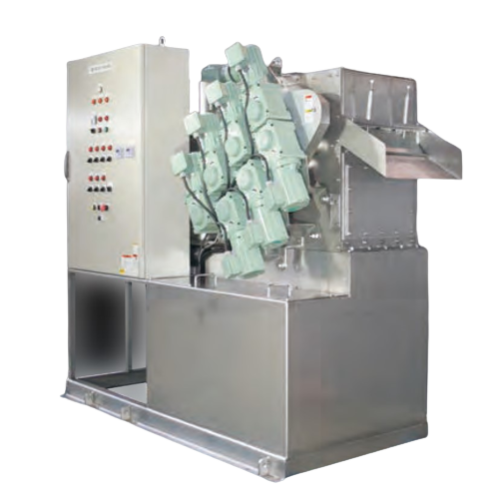Multi-Disc Dehydrators JD Series feature unitized construction that integrates all necessary accessories, and can be more easily installed and are very compact compared with belt presses and centrifugal dehydrators. The dehydrators boast lower noise, reduced energy consumption, and require less water for flushing, thus providing an economical and eco-friendly solution to dehydration applications.
Multi-disc dehydrators utilize both gravity filtration and compression dehydration systems. The “filtering rollers” consist of alternating thin metal discs and resin discs, and are arranged in two (upper and lower) tiers. The coagulated sludge is fed between the rollers and dehydrated by compression while being conveyed toward the sludge outlet by the rotating action of the rollers. The dehydrator main unit requires lower motor output and the filtration surface consists of a ultiplicity of self-cleaning capable discs, and never clogs. Thus, the dehydrator can be used continuously. Multi-disc dehydrators can cope with a wide range of sludge concentrations, and also stably dehydrate sludge that contains high oil content or organic sludge that contains high quantities of inorganic substances.

The MDQ/MDC series features energy-saving construction designed to dehydrate sludge by “gravity filtration + screw volume reduction.” The equipment is of compact unitized construction with all of the necessary accessories and control panel mounted on a common base*, and therefore can be readily installed in very limited floor space. * Not applicable to the MDC-series.
Operators can begin automatic operations of the dehydrator and related accessories by simply and easily operating the included control panel
The filtration surface consists of a multiplicity of discs and a self-cleaning mechanism, therefore it seldom clogs and the equipment can run continuousl
The equipment can stably dehydrate even sludge that contains high oil content. The dehydrator is an optimum solution for treating oily sludge such as DAF froth (mixing with excess sludge) at food processing plants, which filter cloth systems and centrifugal separation processes cannot readily handle. Thus, the equipment boasts a higher solid capture rate.
The dehydrator has both a gravity concentration section and compression dehydration section, and therefore can cope with a wide sludge concentration range of 0.5 to 2.0%.
Because the equipment is constructed to avoid clogging, flushing is not needed in order to restore the original filtration performance. Only showering with a minor amount of water is necessary to wash away sludge that oozes from the dehydration section. Thus, the amount of flush water needed is minimal, and routine maintenance work is not needed.
The dehydrator main unit features a semi-enclosed construction, and runs at an extremely low speed, therefore sludge does not splatter from the equipment. The dehydrator is of eco-friendly design that generates low noise and vibrations, and emits virtually no odors.
The main unit of the multi-disc dehydrator contains multiple rows of “filtering rollers” arranged in two (upper and lower) tiers. Each filtering roller consists of a multiplicity of thick resin discs, small thin stainless steel discs and large thin stainless steel discs. A slit is formed between neighboring discs so that only water drains out. The larger discs of the filtering roller engage with the neighboring filtering roller, causing the slits to be constantly cleaned. Thus, the dehydrator exhibits stable sludge treatment capacity.
The gaps between the upper and lower tiers of the filtering rollers narrow from the sludge infeed inlet to the dehydrated cake outlet; therefore the volume of sludge is moderately compressed. In short, the coagulated sludge fed into the dehydrator main unit is conveyed toward the outlet side as the filtering rollers rotate, during which the sludge is compressed and water drains through the slits, so the sludge is efficiently dehydrated.
| Model | Treating Capacity kgDS/h |
Total Motor Output kW |
Dimensions mm |
Weight kg |
||||
|---|---|---|---|---|---|---|---|---|
| Screw Shaft | Length | Width | Height | Dry | Operating | |||
| MDQ-101 | 3 - 6 | 0.6 | ɸ 100 X 1 | 1800 | 900 | 1800 | 400 | 1000 |
| MDQ-102 | 6 - 12 | 0.7 | ɸ 100 X 2 | 1800 | 900 | 1800 | 500 | 1150 |
| MDQ-103 | 9 -18 | 1.0 | ɸ 100 X 3 | 1850 | 1100 | 1800 | 700 | 1550 |
| MDQ-104 | 12 - 24 | 1.25 | ɸ 100 X 4 | 2100 | 1500 | 2050 | 900 | 1950 |
| MDQ-105 | 15 - 30 | 1.35 | ɸ 100 X 5 | 2100 | 1500 | 2050 | 1000 | 2100 |
| MDQ-201 | 9 - 18 | 1.05 | ɸ 200 X 1 | 2650 | 1200 | 2050 | 700 | 1600 |
| MDQ-202 | 18 - 36 | 1.25 | ɸ 200 X 2 | 2650 | 1200 | 2050 | 900 | 1900 |
| MDQ-203 | 27 - 54 | 1.8 | ɸ 200 X 3 | 2650 | 1500 | 2050 | 1200 | 2550 |
| MDQ-204 | 36 - 72 | 2.35 | ɸ 200 X 4 | 2800 | 2100 | 2050 | 1600 | 3550 |
| MDQ-205 | 45 - 90 | 2.9 | ɸ 200 X 5 | 2800 | 2100 | 2050 | 1800 | 3850 |
| MDC-351 | 36 - 72 | 0.95 | ɸ 350 X 1 | 3770 | 1140 | 2005 | 1300 | 1830 |
| MDC-352 | 72 - 144 | 1.85 | ɸ 350 X 2 | 3930 | 1460 | 2030 | 2300 | 3310 |
| MDC-353 | 108 - 216 | 3.15 | ɸ 350 X 3 | 4220 | 1810 | 2200 | 3300 | 4840 |